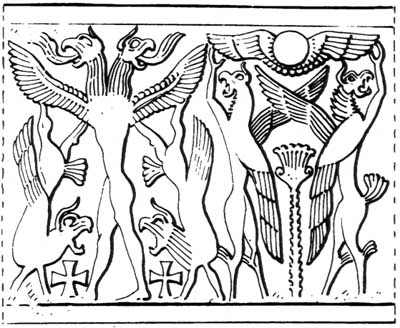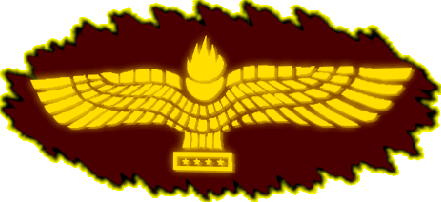Found in the city of Ashur (4.4 cm) The content of this cuneiform document has not been conclusively determined! It seems to be a contract that presumably relates to the royal house1, since the seal of the Assyrian king Eriba-Adad I was impressed upon the tablet. This ruler can be identified as the owner of the seal on the basis of an inscription on another clay tablet impressed by the identical seal. This inscription suggests that the seal used was that of the king.2 The seal impression depicts a pair of lion-griffins with their arms raised, holding a large sun disk. A palm tree stands between them. A second grouping is made up of a double-headed, winged lion demon holding up two liongriffins by their hind legs. Beneath each of their heads is a cross with arms of equal length. The composition of the seal is well balanced, with the two groups given equal weight. Each grouping is composed of self-contained, antithetical motifs, one providing a contrast to the other.3 Comparing this seal impression from the reign of EribaAdad I with the one of Ashur-uballit I from roughly forty years later (cat. no. 67), one can see a difference in style. Despite the similarity in motif and iconography, the carver of the later seal abandoned the attempt to fill the surface and set his clearly outlined figures in space. The heraldic composition of the image was already anticipated in the earlier example and would in time become still more emphatic. The carver of the seal used on the present tablet was a master of his craft. This is especially apparent in the formation of the bodies, the depiction of their musculature, the execution of the heads with what looks like darting tongues or fire, and the details of the delicate feathers. Particularly characteristic of the period are the feathers made up of tiny dots, raised in the impression, on the lower edge of the sun and on the wings of the demon at left. One of a large group of seals of similar design, this is an important example for the development of Middle Assyrian glyptic, which, drawing from various sources, produced a distinctive style of fourteenth-thirteenth century B.C. seals. 1. Pedersen 1985, 23, M 9. 2. See Weber 1920, Pl- 316a: ; Schroeder 1922, 163. 3. Beran 1957,144f, fig. 2. 5. There are many examples in Porada 1948. |
  |